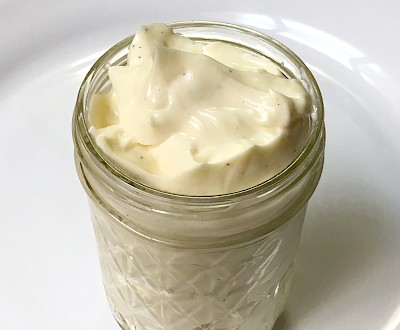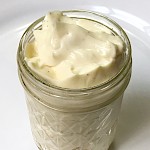

Mayonnaise is a condiment that people either really love or really hate. There's rarely any in-between.
Personally, I mostly fall into the "hate it" category, but it's also a condiment that is bland enough and has the right texture to make it super useful. I frequently use it, combined with heavy cream or sour cream, to stand-in for "cream of" soups in casseroles. It's also the most frequent choice of binder in refrigerator-style salads (eg, tuna, egg, or chicken salad, coleslaw, etc. and so on). So, having a good mayo on hand is a must in a well-stocked keto kitchen.
Now, depending on availability in your area (and availability in your budget) you can find a good quality mayo made with avocado or coconut oil in lieu of Frankenfood seed or soy oils, but sometimes it's easier all-around to just make your own.
As I mentioned, I'm not really a mayo fan, so to make it a lot more palatable (and to give a little extra zip to my concoctions that use it), I turn regular old mayo into "Baconnaise," also known as bacon mayo. The one food that has the potential to make pretty much everything better is bacon, and in the case of mayonnaise... well, let's just say it's not an exception.
Notes: I can whip up my mayo very quickly and easily with my immersion blender, but if you don't have one, that's OK! I included alternate instructions for a food processor. Read them through and know that I really mean it when I say to drizzle slowly.
I'm also not kidding when I say to leave your freshly made mayo out on the counter for 1-3 days. There have been lab studies done on this, and the nutshell is that the anti-bacterial power of the acid in the vinegar, hot sauce, and mustard powder is inhibited by the cold, so putting freshly made mayo right into the fridge stops those ingredients from doing their job fighting salmonella. However, the acids will kill the most bacteria by about 72 hours at room temperature, and a respectable amount of it is gone at the 24-hour mark, so it should be safe to eat after a day unless you're seriously immune-compromised.
So, I'm not nuts on this one. Trust me.
I use light olive oil in my mayonnaise-making, mainly because I don't care for the stronger flavor the other approved oils lend to the emulsion. If you prefer avocado oil, or another friendly oil, feel free to swap it in.
The last note is that I've also included instructions in the notes on how to make just plain, old mayo (it's as simple as using all the oil of your choice and leaving out the bacon grease).
[tasty-recipe id="2786"]



